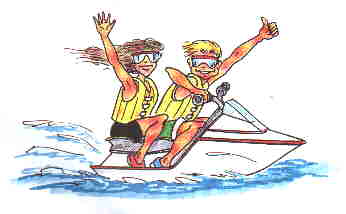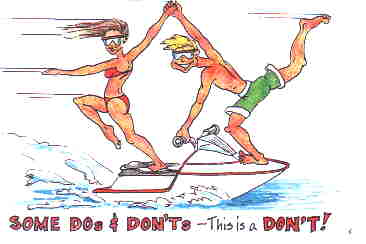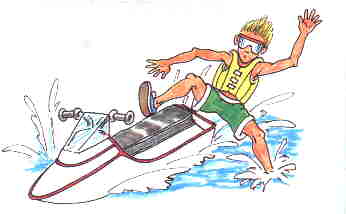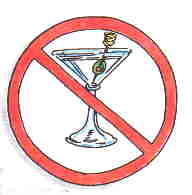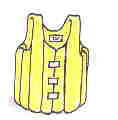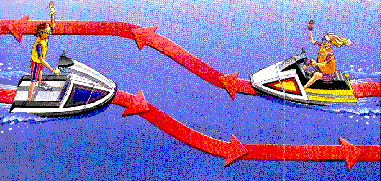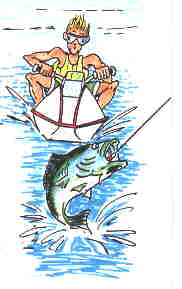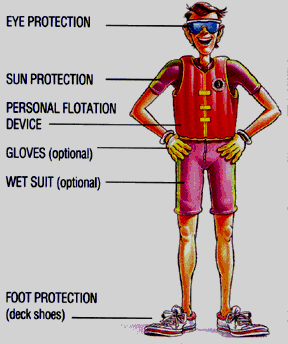
|
PWC TEST |
|
10 WATER SMART MOVES FOR PERSONAL
WATERCRAFT RIDERS
"A PERSONAL WATERCRAFT IS A POWERBOAT, NOT A
TOY. IF YOU OPERATE ONE, YOU ARE THE CAPTAIN,
WITH ALL THE RESPONSIBILITIES FOR KNOWING AND
OBEYING BOATING REGULATIONS, AND PRACTICE
BOATING SAFETY, AS ANY CAPTAIN OF ANY VESSEL."
The Wisconsin Department of Natural Resources reported that in 1996, Personal
Watercraft accounted for 3.16% of all registered boats in the state, 34% of all reported
accidents, 32% of all injuries, and 13.3% of all fatalities. Nationally last year, according
to the Coast Guard, there were 79 fatal PWC boating accidents, and 1,334 PWC
accidents involving injuries. Couple those statistics with sales numbers of personal
watercraft jumping from 29,000 sold in 1987 to nearly 200,000 last year, and it is
readily apparent that personal watercraft owners are drawing the attention of the public
and their legislators.
A Personal Watercraft is defined as a vessel which uses an inboard motor
powering a water jet pump as the primary source of motive power, and
which is designed to be operated by a person sitting, standing, or
kneeling on the vessel, rather than the conventional manner of sitting or
standing inside the vessel.
The U. S. Coast Guard considers personal watercraft, PWC, as Class A
inboard boats. That means personal watercraft are subject to the same
rules and requirements as any other powerboat, and then some.
In addition to the general regulations in effect for motorboats, PWC
owners must also be aware that there are local laws and ordinances
around the country that further restrict PWC operations. They include
age of the operator, sunrise to sunset limitations, special no wake zone
provisions, assigned operating areas and restrictions, and speed limits.
Make certain that you know the laws that apply to you in your area of
operation.
Federal Regs require that all personal watercraft be registered and
display a registration number in accordance with state and federal
guidelines.
Properly fitted, CG approved personal flotation devices (life jackets) are
required for each person on board, and in most states they are required
to be WORN by a PWC operator. There must also be a CG approved,
class B-1 fire extinguisher aboard the PWC.
Many PWC have a lanyard connected to the start/stop switch. If your
PWC is equipped with such a switch, it will not start unless the lanyard is
attached to it. Never start your engine without attaching that lanyard to
your wrist or PFD. If you fall off the engine automatically stops running
so your craft will not travel a great distance, and you can easily swim to
it. It will also prevent the PWC from running amok in areas populated by
swimmers or other watercraft.
PWC operators need to keep in mind that a jet drive requires moving
water through the drive nozzle for maneuverability. If you approach a
dock, shore, or other vessel at a rapid speed and shut off the engine, you
will have little or no maneuvering capability.
The Personal Watercraft Industry Association (PWIA) also recommends
that the operator wear eye protection, a wet suit, footwear, and gloves.
The vast majority of PWC operators are
responsible boaters. They are considerate of the
environment, obey the law, and respect the rights
of others to enjoy our waterways.
Most complaints to law enforcement officials
regarding the operation of PWC's fall into the
following categories. If you are a mature and
conscientious operator, try and avoid these
breeches of common courtesy and
consideration.
Wake jumping! This is not only irritating to boaters attempting to be watchful and
maneuver in heavily travelled areas, but it is extremely dangerous. In just one
case, a wake-jumper in Florida got tangled up in the props of a cabin cruiser and
was killed.
No wake zones! If you want to get on the wrong side of a responsible boater,
disobey no wake zones. You are likely to find yourself on the debit side of a
ticket, since most boaters and shoreline property owners will not hesitate to
report violators of slow-no-wake areas.
High speeds too near shore or other boats! Most states require 100 feet of
separation between boats and to the shore at more than no wake speeds. (By
the way, no wake means the slowest possible speed your boat will go and still
provide maneuverability.)
Noise! Excessive noise near shore or near anchored boats is sure to draw
negative attention. Be considerate of property owners and other boaters.
There are environmental issues that PWC operators need to
consider as well:
Pollution! Refuel on land to reduce chances of spillage into the water. Don't
overfill your fuel tank. Check and clean your engine well away from shorelines.
Turbidity! In shallow waters where PWC's can easily operate, the bottom gets
stirred up, suspending sediment which cuts down on light penetration and
depletes oxygen. This can affect bird and fish feeding. To avoid this, operate
your PWC in deeper water. If you do have to traverse shallow water, run at idle
speed.
Vegetation! In coastal areas be aware of low tide. Low water levels expose sea
grass beds and other delicate vegetation. Disturbances can cause erosion and
long lasting damage. Besides, ingesting seaweed and sea grass is not good for
your engine. Feed it clean water and it will run and maneuver much better.
Wildlife harassment! A PWC near shore can interrupt feeding and nesting
wildlife, and cause animals to deviate from their normal behavior. And that, by
the way, is illegal! Mammals such as sea otters, sea lions, manatees, and whales
can be injured by direct contact with a boat, and it is believed that the noise from
watercraft can even adversely influence breeding cycles and cause birth defects.
So avoid areas of high animal populations.
Remember, our waterways belong to everybody!
If all boaters act responsibly and courteously,
obey the rules, and protect the environment, our
seas, lakes and rivers will provide all of us a
lifetime of enjoyment and recreation!
For more information on this subject, contact the Personal Watercraft Industry Association. Ask for their publications, "Riding Rules for Personal Watercraft" and "An Environmental Guide for Personal
Watercraft Operators". Write: PWIA Communications, 200 W. Welborne Avenue #7, Winter Park, Florida 32789, or call them at 407-629-4941.
